

Stephens, THOMAS (also known in India as PADRE ESTEV?ÉO Or ESTEVAM; less familiarly PADRE BUSTEN, BUSTON, or DE BUBSTON), b. about 1549 at Bulstan, Wiltshire; d. in 1619 at Goa, India. He is admittedly the first Englishman in India. His father was an influential London merchant. Little is known of his boyhood and youth. Though Hakluyt (“Voyages”) and Philip Anderson (“The English in Western India“) believe him to have been educated at New College, Oxford, while A. F. Pollard in the “Dictionary of National Biography” identifies him with the Thomas Stephen of Bourton, Dorset, who was elected scholar of Winchester in 1564, a careful search among the registers of Oxford students gives no evidence of his ever having been at any of the colleges of Oxford. The error of counting Stephens as an Oxonian may easily have arisen from his name having been mistaken either for that of Richard Stephens his brother, who studied at New College, or for that of another Thomas Stephens who is said to have taken his degree at St. John’s College, Oxford, in 1577, when the subject of this article was already a novice at Sant’ Andrea’s in Rome. Though not a student at Oxford, owing to his father’s influential position and to his own brilliant parts, he very probably came into familiar contact with Edmund Campion and several other Catholic Oxford students whose examples may have influenced his subsequent conversion. Soon after he had finished his scholastic career Stephens attached himself to one Thomas Pounde. The perusal of the accounts of the Indian Missions seems to have engendered in them the desire of entering the Society of Jesus. Their common aspirations and a similarity of tastes brought the two friends often together during the persecutions of the English Catholics. Finally, impatient of delay in carrying out their spiritual object, they determined to set out for Rome, but Pounde, betrayed, was doomed to pass the next thirty years in prison. Stephens travelled alone to Rome and entered the Society of Jesus. Having finished his novitiate, Stephens received permission to proceed to India. He sailed from Lisbon (April 4, 1579) and reached Goa, then the principal city of the East Indies, on October 24 of the same year. From Goa he wrote a series of letters to his father, which appear to have held out “the strongest inducements which London merchants had been offered to embark on Indian speculations”, coming, as they did, from one with a thorough grasp of commercial ideas. It has been undoubtedly put forth that these communications on the mercantile chances and possibilities in the East subsequently led to the formation of the East India Company; but, unfortunately, only two of the letters have been preserved. One of them (November 10, 1579), the first he wrote to his father on reaching Goa, is included in Hakluyt’s “Voyages”. The other (October 24, 1583), written in Latin to his brother in Paris, is preserved in part in the National Library of Brussels, and published by Dr. Gerson da Cunha in the “Instituto Vasco da Gama“, II. Fr. Stephens’s first five years were spent as minister of the professed house at Goa, rector of Salsette College, and temporary socius to the visitor. The remaining thirty-five years of his ministry were spent among the Brahmin Catholics of Salsette. His energy and zeal won the devotion of the people and his influence often protected travellers, not only his countrymen, but other Europeans as well.
In the midst of his missionary labors he found time for considerable literary work, though few of his writings remain. The suppression of the Society of Jesus in 1773 and the checkered career of the Konkani race (the descendants of the Brahmin Catholic community of Salsette) destroyed most of his works and renders the drawing up of anything like a complete list impossible. M. Pollard states that Padre Estevâo was the first to make a scientific study of Canarese, that he also learned Hindustani, and that in both these languages he published manuals of piety and grammar. Yet not a single trace of these productions is extant. His greatest surviving work, “The Christian Puranna”, shows that he must have acquired a complete mastery of Marathi and Konkani and of Sanskrit, and it is possible to suppose that he must have written more works with the help of these than are preserved to us. The following list includes all the extant writings: the two letters mentioned above; a Catechism of Christian Doctrine which first appeared under the title, “Doutrina Christâ em lingua Bramana-Canarin, Ordenada a maniera de dialogo para ensinar os meninos, pelo Padre Thomas Estevâo, Jesuita, no Collegio de Rachol” (1622); “Arte de lingua Canarin”, a grammar of the Konkani language, the first grammar of an Indian tongue by a European, chiefly of bibliographical interest (Rachol, 1640), revised and improved by Fr. Diogo Ribiero, S.J., and bearing the imprimatur of the proepositus General of the Society, Fr. Vitelleschi. Only two copies of the first edition are known to exist; a second edition was issued in 1857; “The Christian Puranna” (1616, 1649, and 1654), but no copies of any of these editions are extant. An editio princeps, reproduced from authenticated MS. copies by the present writer, was issued in 1907 from the Jesuit Press at Mangalore, India. “The Christian Puranna” is a Marathi-Konkani metrical composition, consisting of 10,962 strophes, divided into two parts treating of the Old and the New Testament respectively.
JOSEPH L. SALDANHA

